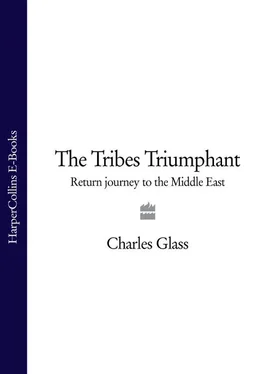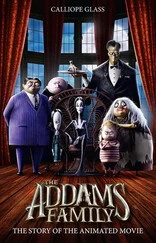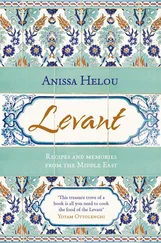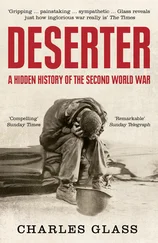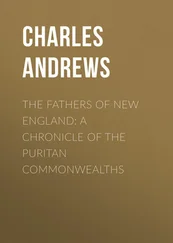Signs indicated the Dead Sea to the south and, later, the King Hussein Bridge straight ahead. A little stand at the side of the road sold boxes of oranges, as on the pre-freeway California highways of my childhood. You could buy the oranges by the box or the kilo, or a man in a straw hat would slice them in two and squeeze them into a pint glass. Nearby, other farmers stacked celery stalks and lettuces on barrel tops to sell to the few passing drivers. We came to a village where I’d have romanticized the unchanging life of donkey carts, camels and its graceful mosque but for the neon and paint logos of the Arab Bank, Sharp, Coca-Cola, the Internet Café and the Green Saloon. At the largest and dustiest roundabout, a cement frame larger than a movie screen surrounded a portrait of the late King Hussein in Prince of Mecca garb: white robes and white keffiyeh, the keffiyeh held by a black egal tied around his head, the robes offset by a belt with a curved dagger in a golden sheath. It was not a poster. Someone had painted the fresco onto wet cement. King Hussein had not been dead long. A complicated man, he had saved his throne from overthrow by socialists, nationalists, communists, Palestinians and Muslim fundamentalists. Like a true Bedouin chief, he had never severed contact with his enemies – whether Nasserite, Israeli or Palestinian – and was wary of his friends – the other Arab monarchs and the Americans. He had outlived the dictators of Syria and Egypt, who had once sworn to replace all the Arab kingdoms with republics like their own. The republican dictators instead adopted regal succession, appointing their sons to replace them when they died. Could it have been otherwise? The Ram ad-Dar, the head of the household, did not leave the fate of the tribe to the masses, as if they could choose a leader with wisdom and strength to lead them. That decision was his, and the only one he could train to confront the world’s cunning and evil ways was his son.
Monarchy went against my beliefs. I knew about Jordan’s prisons. The best that could be said of them was that they were probably not as bad as those in Syria, Iraq, Egypt or Saudi Arabia. People were repressed, but less so than elsewhere in the region. Palestinians in Jordan had a difficult time, but no one stole their homes and threatened to expel them en masse as in Israel and the territories it occupied. No state official prevented them from taking jobs, as in Lebanon. They were not denied passports, as in Syria and Lebanon. The crown that Hussein had passed to his son left Jordan more peaceful than its neighbours.
Beyond the valley’s villages were the Bedouin tents, rows of them in white, beside white sheep and a tethered white donkey. About five miles short of the river was Jordan’s lazy border post. Within its walls, a triangular yard was bounded by an arrival hall, a departure hall and a café. A rusting bus waited in the middle to deliver the day’s last shipment of travellers to the other side. I made the mistake of walking into the departure building, whose offices were locked and whose windows for three different categories of traveller – Arab, Jordanian, non-Arab – were shut. A policeman in starched khaki guided me to the arrivals building. Since the intifadah began in September 2000, one room served both purposes. I filled in forms and a polite official stamped my passport. I paid the five Jordanian dinar departure tax and boarded the unlit bus with a driver and three other passengers: an old man in a white keffiyeh; his wife in a white scarf and a beautiful olive dress embroidered in scarlet eagles’ wings and pink rosebuds; and a younger man in a lightweight business suit. He called the old man ‘Haj’, a title of respect for someone who had made the pilgrimage to Mecca. Christians who had gone to Jerusalem were also called ‘Haj’.
At five o’clock, the driver pulled the door shut. After a few warm-ups, the engine started. As the bus turned to leave the post, we saw the last royal portrait, of the two kings, father and son, Hussein and Abdallah. A gold crown hovered in a fair blue sky above them, a trinity whose spirit might pass from head to head but was eternal in its protection of the people, of the family, of the tribe.
I was thinking of something Prince Talal had said to me the night before. Talal, like his uncle, the late king, and his first cousin, King Abdallah, had received his formal education abroad. His school was Harrow, and his undergraduate and graduate degrees were from Georgetown. He rode motorcycles and liked Western music. He was a crack shot and a good horseman. He said that Western politicians who met people like himself thought of them as ‘good Arabs’. I paraphrase what he said, because I did not write it down. It went something like this: ‘I dress like them. So they think I am not really an Arab. It’s like being an honorary white. But I am as much an Arab as any Bedouin who has never left the desert. And, if I have to choose, I choose to be an Arab.’
He had just told me that Jordan had arrested some of the Islamic fundamentalists of Osama bin Laden, who had tried to blow up a Jordanian phosphate plant. The Jordanians were passing information about threats to Americans in the US and the Middle East to Washington. They wanted to help, especially when the fanatics were as opposed to the Hashemite throne as to the American government. But they could not go all the way, as President George Bush demanded with his ‘You’re either with us or against us’ speech. Nor could Jordan support General Sharon’s self-proclaimed ‘war on terror’ that was a war on Palestinians under military occupation. Jordan could not, however much it disapproved of Saddam Hussein’s atrocities, favour the sanctions that deprived Iraq’s people of medicine and of equipment for the restoration of sewage treatment and other basic services. To Talal, there were no good and no bad Arabs, measured on a scale of Americanization. There were good and bad people based on their humanity.
The sky in the king’s fresco was a clearer blue than the one towards which our bus rumbled across the deserted plain. We came to sets of metal gates and a long runway, as if we would fly into the darkening horizon over the River Jordan and into Canaan in our sweet chariot. This was no-man’s-land, the nether-world that separated each state of Greater Syria from the other. No one lived here. No one governed the tribal buffer. No farmers farmed, no livestock grazed and no trees cast shadows to obstruct the view from either side of the other. Concrete pillars – dragon’s teeth, in American military parlance – stood sentry at intervals of ten yards on both sides of the highway. I don’t know if the land was mined against infiltrators, but nothing grew out of that cement-powder soil. Two miles of protected desolation brought the bus at last to the ‘Police Security Directorship – Bridge Security’. Metal screamed on metal, as the ancient brakes of our border shuttle stopped us crashing into the gates. A Jordanian policeman boarded and collected vouchers that confirmed we had paid the departure tax. The driver slammed the doors, fired up the engine again and released the brake. We rolled past a sign, the last I would see in Jordan. It wished us all ‘Bon Voyage’.
The first Israeli fence was a little further. We stopped. We waited. We waited a long time. The old man sitting in front of me, who had been patient for a quarter of an hour, was the first to speak. ‘Why are we waiting?’ ‘Who knows?’ the driver answered. His daily route between the two border stations had accustomed him to waiting. This was his last trip of the day, and he would return empty. The old Haj repeated his question: ‘Why do they make us wait so long?’ The other passenger, the man in the suit, told him, ‘Be patient, Haj.’ The Haj looked at his wife, who smiled at him, and shrugged. The driver got out and opened all the luggage compartments for inspection by two Israeli soldiers. He drove on to a second gate, where a sign said, ‘Welcome to the Allenby Bridge Crossing Point’. We were still on the East Bank, waiting to cross a tiny suspension bridge that the Israelis, following the British, named for General Allenby and the Jordanians called the King Hussein Bridge.
Читать дальше
